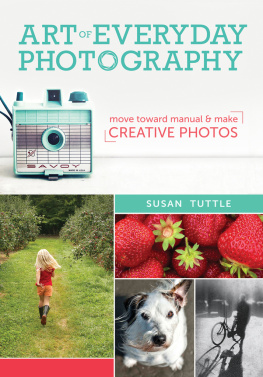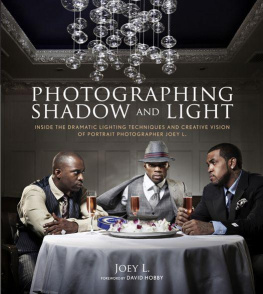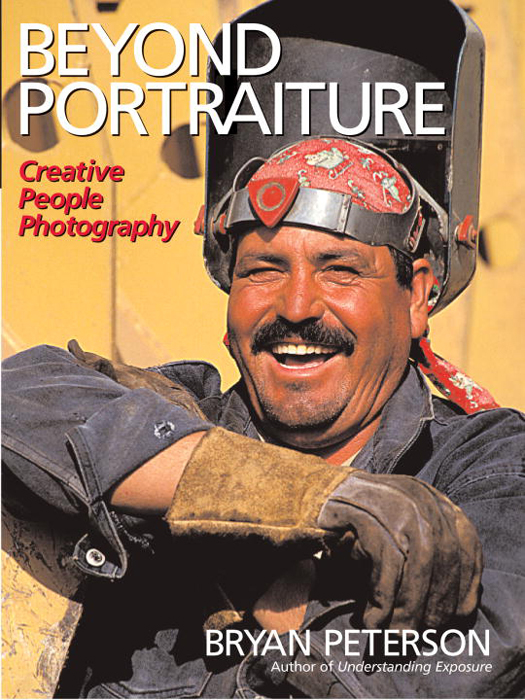
80mm, f/8
Editorial Director: Victoria Craven
Senior Development Editor: Alisa Palazzo
Designer: Bob Fillie, Graphiti Design, Inc.
First published in 2006 by Amphoto Books an imprint of the Crown Publishing Group, a division of Random House, Inc.,
New York
www.amphotobooks.com
www.crownpublishing.com
Text and illustrations copyright 2006 Bryan Peterson
Cover design by Bob Fillie, Graphiti Design
Front cover photograph by Bryan Peterson
Typeset in Frutiger Light
Library of Congress Cataloging-In-Publlcatlon Data
Peterson, Bryan F.
Beyond portraiture : creative people photography / Bryan Peterson.
p. cm.
Includes index.
eISBN: 978-0-8174-0027-9
1. Portrait photography. I. Title.
TR575.P468 2006
778.92dc22
2006005309
All rights reserved. No part of this publication may be reproduced or used in any form or by any meansgraphic, electronic, or mechanical, including photocopying, recording, or information storage-and-retrieval systemswithout the written permission of the publisher.
v3.1

To my daughter Chlo, eyes so deep brown
Laughing, smiling, seldom a frown
Sunset to sunrise, night turns to day
Ill always love you, Ill always say!
Contents
Introduction
People are the most photographed subjects in the world because pictures of people tug at our hearts and they are, in many ways, pictures of ourselves. A full-frame portrait of a sad and teary-eyed three-year-old will touch most of us. We may not know the specific reasons for the tears, but we can feel the pain. Conversely, three elderly people sitting on a front porch laughing hysterically may generate a number of interpretations, but one thing is certain: everyone can understand and appreciate the meaning of laughter. In addition, most of us have someone to thanka mother, father, relative, or friend who had a camera in handfor forever preserving small yet revealing vignettes of our personal histories.
Unlike photographs of snowcapped mountains, autumn landscapes, or colorful sunsets, photographs of family, friends, acquaintances, and even strangers trigger much deeper emotions. Many people are reminded of their youth as they look back on images of yesterday; that a photo reminds people of an easier time is the most often-heard response from viewers. Your children, just as you were with your parents, are amused by pictures of you with your beehive hairdo, white bobby socks, miniskirts, or bell-bottom jeans. You tell your children that you had to be there when explaining your appearance back then and are quick to remind them that they, too, will look back with both nostalgia and perhaps even embarrassment at the pictures you took of them just last week. Whatever possessed me to wear baggy jeans around my knees and have orange hair? your son or daughter might say.
At other times, photographs of people taken last yearor even todaygive pause for reflection. You sigh and wonder where the time goes as you look at ten-year-old photographs of yourself and those you love. You are moved to tears and laughter as you stare at your photo album when your daughter of eighteen years, two months, and four days is about to leave for college halfway across the country.
How you photograph your loved ones, friends, and even strangers can reveal something about you. Do you find that your favorite pictures show people in a vast landscape, causing them to appear small and diminished? Perhaps compositions of this type reflect your own feelings of being overwhelmed by life at times or of just how lonely life can be or even, still, of how small you feel. On the other hand, do you find most often that you are filling the frame with just the face of your subjects? Such compositions might reflect the great compassion you feel toward people, as well as call attention to your ability to feel free enough to interact with most anyone. The reasons why you do what you do are numerous and, in part, they define who you are; but photographyunlike any other mediumcan say volumes about you (by how you shoot your subjects) in a single stroke.

160mm, f/5.6
My photography career didnt begin with people as my main interest. Waterfalls and forests, flowers and bees, lighthouses and barns, and sunrises and sunsets drew 99 percent of my attention. This continued for more than ten years until one day I found myself composing yet another snowcapped peak reflected in a still foreground lake. That day proved to be a turning point as I began to reflect on the absence of people not only in my private life, but equally so in my pictures. Spending countless days and weeks in nature was making me lonely!
For the next five years, I found myself making a slow but deliberate transition: I spent less and less time shooting peopleless compositions. I felt a new passion as I realized that the most vast and varied photographic subject was people. I felt lucky! As the song goes, people who need people are the luckiest people in the world. And, I was quick to discover that my camera could be a bridge in introducing myself to peoplebut I still had one hurdle to overcome.
Whether I spoke the language of my subject or not, I was quick to learn many things about myself. Since Im normally an outgoing person, I was amazed to discover just how shy I really was. On more than one occasion, I resolved to abandon my interest in people photography. After all, my landscape and close-up photography was already well received by magazine, greeting card, and calendar publishers. And, of course, there was one big distinction between nature subjects and people: mountains didnt move, flowers didnt stiffen up (or throw nectar in your face!), and butterflies never once asked for payment.
But try as I might, I couldnt silence the steady voice inside me that kept pushing me to return to people as subjects. The voice would grow louder when I saw particularly striking subjects, such as a lone ice cream vendor in a city square surrounded by hundreds of pigeons, a woman dressed in red walking parallel to a blue wall with her white poodle leading the way, or a white-bearded man of eighty-plus years sitting on a park bench and chuckling as he read an Archie comic book. But even during those obviously great picture-taking opportunities, I seldom was courageous enough to raise my camera to my eye and take the picture. That wave of photographic shyness would come over me.
I could only conclude that I was afraid of both rejection and intimacy. Unlike the landscapes I was so familiar with, people can, and oftentimes do, talk back, and they do have something to say. Sometimes, potential subjects would say exactly what I didnt want to hear and refuse to let me take their picture. But when I heard a yes response to my request, my anxiety over being rejected was quickly replaced by the fear of intimacy. Unlike a flower, which needs no coaxing, people require interaction: I had to get involved with my subjects if I had any hope for spontaneity. Otherwise, if I just simply raised the camera to my eye and took the picture, my subjects would immediately become self-conscious. It was as if I were the doctor with a huge hypodermic needles about to administer the shot of their life.














